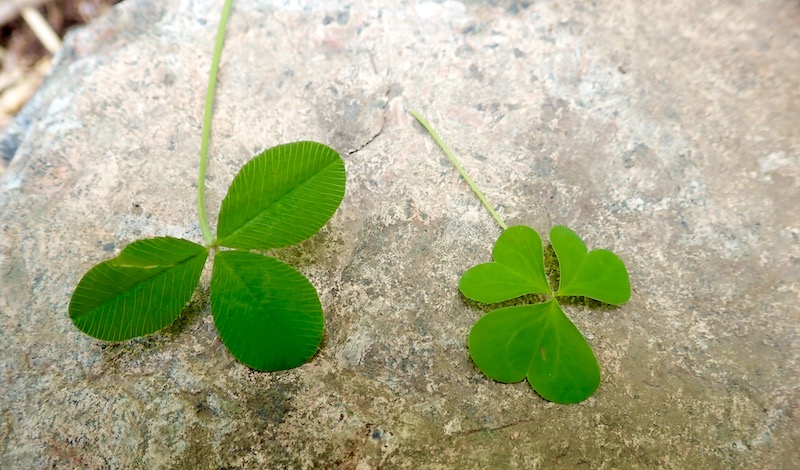Your cart is currently empty!

We all know that shamrock, or three leaf clover is a symbol and official trademark of Ireland, right? I thought that too. It is interesting how when brain hears something for thousand times it just assumes that it is the fact, or the truth…
Clover or wood sorrel?
It all started a couple weeks ago when a friend posted a picture of a green leaf and referred to it as clover. And I know my clovers:-) So I look and see that it is a perfect wood sorrel, that I have eaten from childhood, so I correct her, and slowly over the course of several days it creeps up on me, that there is a hidden misconception waiting to be discovered.
So I search and search online articles in two languages and only in one place do I find a reference to a wood sorrel in connection with Ireland. It turns out that pre Christian Irish or Celts loved to eat wild wood sorrel for its nutritional and healing properties, and carried its depictions on their clothing. The wise old Druids often advised the Irishmen of their time to consume wood sorrel because it would make them strong and speedy in battles. It was a sacred symbol to them and possibly represented the Mother Nature’s power of regeneration.
St. Patrick
Later on when St. Patrick brought christianity to Ireland, he used the leaf of wood sorrel as his reference to trinity (three leaves in one). Four leaf is an exception, and according to the legend you can only find it once in 10000 times. And it represents love, hope, faith and luck.
It was so dear to peoples hearts already, so the image stuck. However the word clover is used now.
Look at the clover in your yard

When you look at the clover leaf it has three roundish lobes that come together at the center. Wood sorrel also has three lobed leaf, except the lobes are heart shaped, and they fold in half for the night, and unfold again in the morning. So take a look at shamrock symbol and see. Also go outside and find a white or red clover and check out the leaves.
In Gaelic (Irish) language as far as I could find the word “seamar” or “seamair” means “clover”. And the word “seamsog” means wood sorrel. So somehow the words got synergised into “shamrock”, representing the symbol.
Wood sorrel
So what is a wood sorrel? It is a small plant that grows in your lawn, grass, garden, and in the woods. It has three lobed heart shape green leaves, it blooms with a little yellow flower where I live, and whitish, pink or purple ones in other parts of the world. Sometimes the leaves are purple instead of green.
It is rich in oxalic acid (genus Oxalis means “sour”) like some other plants including spinach, broccoli, and rhubarb. So drink lots of water when eating wood sorrel. Also avoid dairy products, if possible, as the oxalic acid binds strongly to calcium to make calcium oxalate, which is the key mineral of the kidney stones.
Possessing vitamins A, C, all part of the plant reduce fevers and relieve indigestion.
It treats scurvy, urinary infections, mouse sores, nausea and sore throats.
Vegetable soup
I love its lemony, tangy flavor in a vegetable soup. Just mix chopped onions, carrots, potatoes and water, boil until done, add wood sorrel leaves and chopped boiled egg. It can also be used as tea.
In Russian it is called Kislitcha, which means sour one, or bunny’s cabbage. It is used for mercury poisonings as antidote. It is used to improve appetite and metabolism.
It grows all over the world in Europe, Mexico, South Africa, Australia, Brazil. When it is done blooming, it makes seed pods, narrow, and somewhat similar to peapods. The seeds shoot out from the pods to more then 1,5 yards distance. Ants love to carry the seeds and stash them away for winter. You can make the pods open and shoot if you breeze on them, the temperature/humidity change and the seeds are released. It folds its flowers before rain.
So next time you say clover, please remember it might be a wood sorrel:-)

Leave a Reply